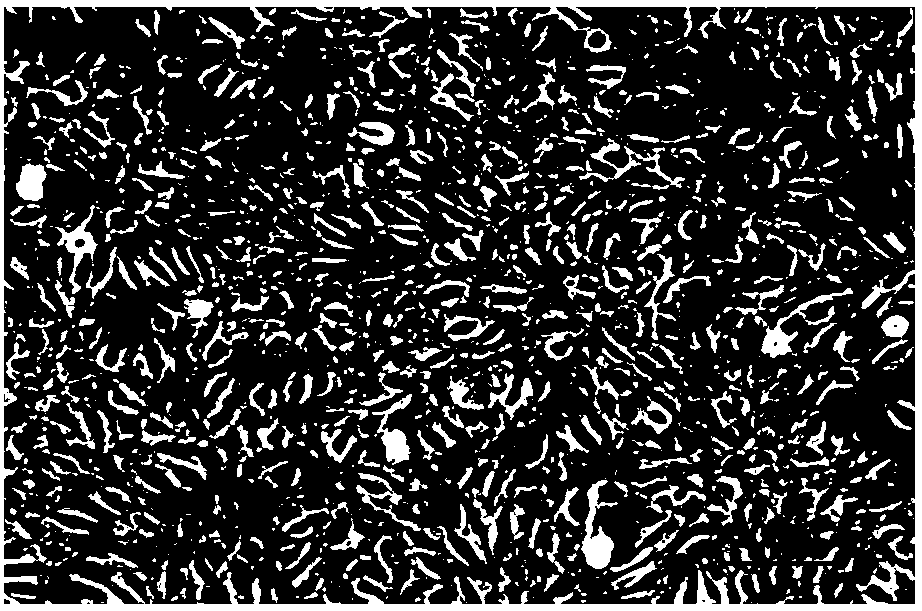Establishment method and applications of microfluidic-chip-based tumor infiltration model
A microfluidic chip and chip technology, applied in the field of cell biology research, can solve the problem that the movement characteristics of circulating tumor cells are in a blank stage
- Summary
- Abstract
- Description
- Claims
- Application Information
AI Technical Summary
Problems solved by technology
Method used
Image
Examples
Embodiment 1
[0041] Establishment of Vascular Inflammation Lesion Model Using Brain Microvascular Endothelial Cells
[0042] Using the microfluidic chip designed and manufactured by the laboratory, the structure is as follows: figure 1 shown. Prepare a type I rat tail collagen working solution with a concentration of 0.1mg / mL, inject it into the chip through the cell inlet, and let it stand overnight at room temperature. After 24 hours, remove the collagen working solution, and wash the channel 3 times with the cell culture solution. Dilute the brain microvascular endothelial cells to a concentration of 5×10 6 Cells / mL cell suspension, add 100 μL of cell suspension into the chip through the cell inlet, under the modification of collagen, the cells quickly adhere to the wall and spread evenly on the bottom of the cell culture chamber, when the cells are observed under the optical microscope When the cells are evenly distributed in the culture room, immediately move the chip into the carbo...
Embodiment 2
[0044] Characterization of Intracellular Functional Proteins in a Cerebral Microvascular Inflammation Model
[0045] Using the microfluidic chip designed and manufactured by the laboratory, the structure is as follows: figure 1 shown. After chip modification, the same cell inoculation and culture methods as in Example 1 were used to establish a cerebral microvascular inflammation model. After 24 hours of stimulation, immunofluorescence staining was performed on the cells, and the monitored proteins were carbon monoxide synthase (eNOS), von Willebrand factor (vWF), integrin β4 (Intβ4), vinculin, and endothelial cell adhesion molecule- 1 (VCAM-1) and intercellular adhesion molecule-1 (ICAM-1), photographed under a fluorescent microscope, and recorded the expression of the corresponding proteins, the results are as follows Figure 4 shown.
Embodiment 3
[0047] Adhesion and rolling of lung cancer cells on the surface of brain microvascular endothelial cells under fluid shear force
[0048] Using the microfluidic chip designed and manufactured by the laboratory, the structure is as follows: figure 1 shown. After chip modification, the same cell inoculation and culture methods as in Example 1 were used to establish a cerebral microvascular inflammation model. Then the lung cancer cells were digested and diluted into a cell suspension with a concentration of 1×10 6 cells / mL, through the cell entrance into the channel, the microscope continuously photographed the adhesion and rolling phenomenon of lung cancer cells on the surface of brain microvascular endothelial cells, and counted the number of lung cancer cells that adhered and rolled. The results are as follows: Figure 5 shown. Figure 6 Adhesion and rolling of lung cancer cells on the surface of brain microvascular endothelial cells under the action of different molecules...
PUM
 Login to View More
Login to View More Abstract
Description
Claims
Application Information
 Login to View More
Login to View More - R&D Engineer
- R&D Manager
- IP Professional
- Industry Leading Data Capabilities
- Powerful AI technology
- Patent DNA Extraction
Browse by: Latest US Patents, China's latest patents, Technical Efficacy Thesaurus, Application Domain, Technology Topic, Popular Technical Reports.
© 2024 PatSnap. All rights reserved.Legal|Privacy policy|Modern Slavery Act Transparency Statement|Sitemap|About US| Contact US: help@patsnap.com










